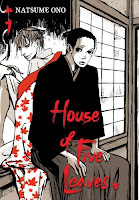 Creator: Takehiko Inoue
Creator: Takehiko Inoue
U.S. publisher: Viz Media
ISBN: 9781421522456
Released: April 2009
Original release: 2000-2001
Awards: Japan Media Arts Award, Kodansha Manga Award, Tezuka Osamu Cultural Prize
The third volume in Viz Media’s omnibus release of Takehiko Inoue’s manga series Vagabond collects the seventh, eighth, and ninth volumes of the original edition. Those volumes were initially published in Japan between 2000 and 2001 and then in English by Viz Media between 2003 and 2004. The third omnibus was released by Viz Media in 2009. Inoue’s Vagabond is based on Eiji Yoshikawa’s epic historical novel Musashi, which is a retelling of the life of the legendary swordsman Miyamoto Musashi. In addition to being an extraordinary adaptation, Vagabond has also earned Inoue a Japan Media Arts Award, a Kodansha Manga Award, and a Tezuka Osamu Cultural Prize among other honors. Because March 2013’s Manga Moveable Feast celebrates historical manga, I thought it was the perfect opportunity to dig into Vagabond again.
Along his journey to determine and prove his worth as a swordsman, Musashi confronted Inshun, the second-generation master of the Hōzōin spear technique. Musashi nearly lost his life in the resulting encounter and was forced to retreat. Ashamed that he ran away from the battle, Musashi has been developing his mind and body in the nearby mountains. Surprisingly enough, he is training under the guidance of In’ei, Inshun’s master. Musashi struggles to conquer the fear that the battle with Inshun has instilled in him. As for Inshun, never before having the opportunity to experience mortal combat, he looks forward to the chance to fight Musashi again. Although their goals may be similar, both young men have their own reasons for seeking to become stronger and more powerful.
One of the prominent themes in this particular omnibus of Vagabond is fear and, more specifically, how the characters deal with that fear. Both Musashi and Inshun have their own personal demons to face, but they confront their fears in very different ways. Musashi tends to approach things head on while Inshun subconsciously attempts to bury much of his past. These differences not only influence their personalities, but their martial abilities and fighting styles, as well. Becoming a skilled fighter and following the way of the sword isn’t just about brute strength, a lesson that Musashi is still trying to learn and master. Strategy, awareness, and mental clarity and preparedness are also extremely important. For a fighter, a strong mind is just as crucial as a strong body, especially when dealing with matters of life and death.
Another point that is emphasized through Inshun and Musashi’s conflict is the need to be able to see and understand not only the details of a situation but also that situation as a whole. This is something that is reflected nicely in Inoue’s artwork. In Vagabond, Inoue uses a detailed, realistic style which works superbly with the story’s realistic approach to traditional martial arts. I love the attention that Inoue devotes to the characters’ physical presences—their feet, stances, and grounding. At the same time he conveys the intensity of their mental and emotional states through their facial expressions, eyes, and demeanor. Inoue’s focus on these and other details doesn’t overwhelm the larger picture; instead, it enhances it. Vagabond is a great adaptation but the cohesive vision that Inoue brings to both the story and the art makes it a marvelous work in its own right. I certainly look forward to reading more.




